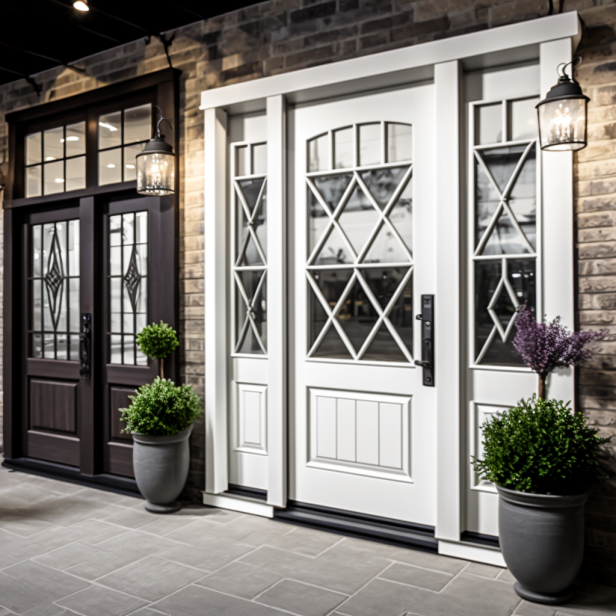A front door is more than just an entry point to your home – it’s the first thing people see when visiting. It can significantly affect your property’s curb appeal and overall value. But with so many options available in terms of design, material, cost, and installation, choosing the right front door for your home can be overwhelming. In this comprehensive guide, we’ll walk you through the factors to consider and the steps to pick the perfect front door that suits your style, budget, and needs.
Step 1: Determine your style
The style of your front door should match the architecture and decor of your home. Whether you have a modern, contemporary, traditional, or rustic home, there are front door designs that can complement and enhance its look. Some popular styles of front doors include:
- Classic wooden doors with ornate carvings and panels
- Contemporary doors with sleek lines and minimalist hardware
- Glass doors with frosted, stained, or leaded glass for privacy and aesthetics
- Steel doors with embossed textures and colors for durability and security
- Fiberglass doors with wood-grain textures and energy-efficient features
Consider the color of your front door as well – a bold, bright, or contrasting color can make your home stand out and create a welcoming focal point.
Step 2: Measure your size
Your front door’s size should match your home’s dimensions and the width of your entryway. Standard front doors are usually 36 inches wide by 80 inches high. Still, you can also find custom sizes that fit your specifications. To ensure a proper fit, measure your entryway’s height, width, and depth, including the door jamb and threshold.
Step 3: Choose your material
The material of your front door affects its durability, energy efficiency, maintenance, and cost. Here are some common materials used for front doors and their pros and cons:
- Wood: classic, elegant, and natural, but requires regular maintenance, may warp or rot over time and can be expensive.
- Steel: strong, secure, and low-maintenance, but may dent or scratch, conduct heat or cold, and have limited design options.
- Fiberglass: versatile, energy-efficient, and low-maintenance, but may fade or crack over time and have limited color options.
- Aluminum: lightweight, durable, and corrosion-resistant, but may dent or scratch easily, conduct heat or cold, and have limited design options.
- Glass: decorative, light-filtering, and elegant, but may be fragile, require privacy features, and compromise security.
Consider your home’s climate, location, and exposure when choosing the material for your front door.
Step 4: Calculate your cost
The cost of your front door depends on various factors, such as the material, design, size, features, and installation. Here are some average prices for front doors:
- Wood doors: $500 to $5,000
- Steel doors: $200 to $1,000
- Fiberglass doors: $150 to $2,000
- Aluminum doors: $500 to $2,000
- Glass doors: $500 to $5,000
Remember that the cost of installation, hardware, and accessories, such as locks, handles, hinges, and weatherstripping, can add up to the total cost.
Step 5: Install your door
Your front door installation should be done by a professional installer with the expertise, tools, and safety measures to ensure a proper and secure fit. The installation process includes the following:
Removing the old door and hardware
- Measuring and cutting the new door to fit
- Installing the frame, hinges, and threshold
- Securing the door with screws and weatherstripping
- Testing the functionality, security, and energy efficiency of the door
Choose a reputable, licensed installer who offers a warranty and follows your area’s building codes and regulations.
Step 6: Maintain your door
The maintenance of your front door depends on the material and finish of the door. Here are some tips to keep your front door in good condition:
- Wood doors: sand, stain, and seal the door every few years to prevent rot, warping, and fading
- Steel doors: clean and lubricate the hinges and hardware regularly to prevent rust and corrosion
- Fiberglass doors: clean with mild soap and water, and avoid using abrasive cleaners or solvents
- Aluminum doors: clean with a non-abrasive cleaner and avoid using sharp objects that can scratch the surface
- Glass doors: clean with a glass cleaner and avoid using abrasive sponges or cloths that can irritate the glass
Inspect your front door regularly for any wear, damage, or malfunction. Repair or replace any parts as needed.
In conclusion, choosing the perfect front door for your home requires careful consideration of the style, size, material, cost, installation, and maintenance factors. By following these steps and consulting with a professional installer, you can pick a front door that enhances the look and value of your home and provides security, energy efficiency, and durability. Furthermore, taking these precautions can ensure that your investment is well worth it in the long run.

